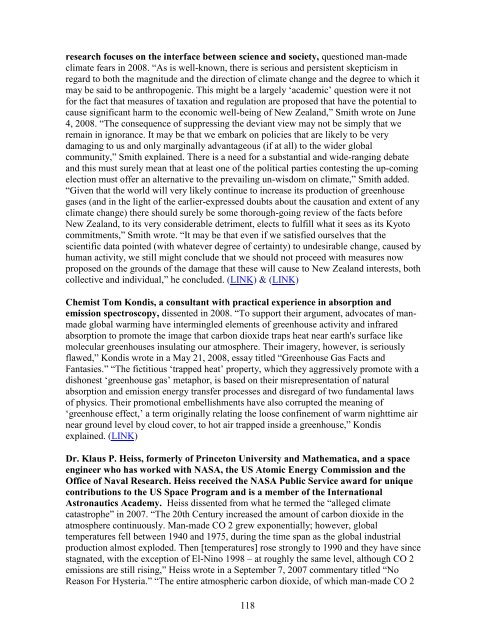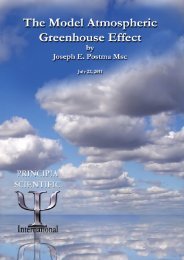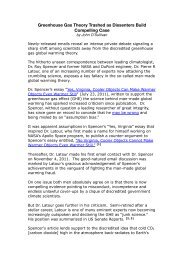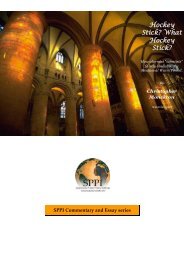Than 1000 International Scientists Dissent Over Man-Made Global ...
Than 1000 International Scientists Dissent Over Man-Made Global ...
Than 1000 International Scientists Dissent Over Man-Made Global ...
Create successful ePaper yourself
Turn your PDF publications into a flip-book with our unique Google optimized e-Paper software.
esearch focuses on the interface between science and society, questioned man-made<br />
climate fears in 2008. ―As is well-known, there is serious and persistent skepticism in<br />
regard to both the magnitude and the direction of climate change and the degree to which it<br />
may be said to be anthropogenic. This might be a largely ‗academic‘ question were it not<br />
for the fact that measures of taxation and regulation are proposed that have the potential to<br />
cause significant harm to the economic well-being of New Zealand,‖ Smith wrote on June<br />
4, 2008. ―The consequence of suppressing the deviant view may not be simply that we<br />
remain in ignorance. It may be that we embark on policies that are likely to be very<br />
damaging to us and only marginally advantageous (if at all) to the wider global<br />
community,‖ Smith explained. There is a need for a substantial and wide-ranging debate<br />
and this must surely mean that at least one of the political parties contesting the up-coming<br />
election must offer an alternative to the prevailing un-wisdom on climate,‖ Smith added.<br />
―Given that the world will very likely continue to increase its production of greenhouse<br />
gases (and in the light of the earlier-expressed doubts about the causation and extent of any<br />
climate change) there should surely be some thorough-going review of the facts before<br />
New Zealand, to its very considerable detriment, elects to fulfill what it sees as its Kyoto<br />
commitments,‖ Smith wrote. ―It may be that even if we satisfied ourselves that the<br />
scientific data pointed (with whatever degree of certainty) to undesirable change, caused by<br />
human activity, we still might conclude that we should not proceed with measures now<br />
proposed on the grounds of the damage that these will cause to New Zealand interests, both<br />
collective and individual,‖ he concluded. (LINK) & (LINK)<br />
Chemist Tom Kondis, a consultant with practical experience in absorption and<br />
emission spectroscopy, dissented in 2008. ―To support their argument, advocates of manmade<br />
global warming have intermingled elements of greenhouse activity and infrared<br />
absorption to promote the image that carbon dioxide traps heat near earth's surface like<br />
molecular greenhouses insulating our atmosphere. Their imagery, however, is seriously<br />
flawed,‖ Kondis wrote in a May 21, 2008, essay titled ―Greenhouse Gas Facts and<br />
Fantasies.‖ ―The fictitious ‗trapped heat‘ property, which they aggressively promote with a<br />
dishonest ‗greenhouse gas‘ metaphor, is based on their misrepresentation of natural<br />
absorption and emission energy transfer processes and disregard of two fundamental laws<br />
of physics. Their promotional embellishments have also corrupted the meaning of<br />
‗greenhouse effect,‘ a term originally relating the loose confinement of warm nighttime air<br />
near ground level by cloud cover, to hot air trapped inside a greenhouse,‖ Kondis<br />
explained. (LINK)<br />
Dr. Klaus P. Heiss, formerly of Princeton University and Mathematica, and a space<br />
engineer who has worked with NASA, the US Atomic Energy Commission and the<br />
Office of Naval Research. Heiss received the NASA Public Service award for unique<br />
contributions to the US Space Program and is a member of the <strong>International</strong><br />
Astronautics Academy. Heiss dissented from what he termed the ―alleged climate<br />
catastrophe‖ in 2007. ―The 20th Century increased the amount of carbon dioxide in the<br />
atmosphere continuously. <strong>Man</strong>-made CO 2 grew exponentially; however, global<br />
temperatures fell between 1940 and 1975, during the time span as the global industrial<br />
production almost exploded. Then [temperatures] rose strongly to 1990 and they have since<br />
stagnated, with the exception of El-Nino 1998 – at roughly the same level, although CO 2<br />
emissions are still rising,‖ Heiss wrote in a September 7, 2007 commentary titled ―No<br />
Reason For Hysteria.‖ ―The entire atmospheric carbon dioxide, of which man-made CO 2<br />
118





